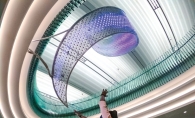A sculptural memorial reminds those who can remember and teaches those who can’t. So when you’re walking around Centennial Lakes and find a girl and a boy frozen in time, you might merely appreciate their childlike wonder or, if you grew up in the 1950s, you might look more carefully.
The 5-year-old boy sits on a rock, examining a model airplane. The 10-year-old girl skips off the ground. She holds her own model airplane aloft, as if she and the little Boeing 747 could achieve lift. They might remind baby boomers of a time when flight meant magic and excitement rather than TSA troubles and cramped legroom. Sculptor Nick Legeros made the two figures out of bronze. They tell the romantic story of commercial flight’s early years, but if you look even more closely, you’ll find the story of former Northwest Airlines chief executive Donald Nyrop, who helmed the Minnesota airline during its golden years.
The boy’s model airplane, a Convair 580, coursed the tarmac when Edina resident Nyrop first joined Northwest in 1952. When Nyrop left in 1978, he had purchased Boeing 747s for the airline. “And those two planes are to scale,” Legeros says of the bronze models. “You look at that tiny twin-engine plane that the boy has, compared to the monstrous 747 that the girl has—and that bookends Don Nyrop’s career.”
The bronze girl and boy, titled Dreams Take Flight, comprise one of the two sculptures commissioned last summer by former Northwest president John Horn to honor the airline that Donald Nyrop shaped. (Nyrop died in 2010.) The second sculpture, The Glamorous Days of Flight, also flanks Centennial Lakes. It imagines a family of four walking through a door that’s curved to suggest a fuselage.
“Nyrop took over an airline that was falling apart,” Horn says of Northwest. “You’ll find that we had a lot of accidents. We were losing money hand over fist.” Nyrop turned the company into one of the nation’s safest and most steadily profitable airlines, according to his obituary in the New York Times.
Nyrop also fought with the pilot and machinist unions. He faced off many strikes. “His reputation was that he was tight-fisted,” Horn says.
Inspired by statues in the Centennial Lakes promenade, Horn partnered with the Edina Community Foundation to raise money for a sculptural memorial. Horn talked with Nyrop’s family. They decided a bust would not do. “It’s too ‘Look at me,’ ” Horn says. Nyrop refused to publicize the money he lent to struggling employees and their families. “When Nyrop retired, the pilots—who supposedly fought with him the most—had a birthday party for him,” Horn says. “These pilots, who had almost been out of jobs, retired flying 747s.”
A memorial underscoring Nyrop’s priority—his business—would suit his memory more than a bust.
So, with help from past Northwest employees, the Edina Community Foundation raised about $140,000.
Dick Crockett, executive director, enlisted Legeros to design and build the two sculptures.
Crockett had seen Legeros’ works around town, first at City Hall: a bronze girl and boy chasing bubbles, made in memory of an area nursery school that had closed.
“One thing about Nick’s work is that it’s easy to relate to,” Crockett says. “It’s not exactly literal, like if you were to do a bust of somebody. It has one degree of abstraction, meaning the artist has molded it a bit. You know what it is, but it’s not exactly as it would be.”
To brainstorm ideas for the two sculptures, Legeros interviewed about 15 former employees at the Northwest Airlines History Center. Many of them recalled the prestige of working for an airline in the 1960s and 1970s. “That experience where everyone was dressed up. The woman’s got a pillbox hat on, the kids are thrilled they get to go on an airplane,” Legeros says. “I really thought about the jet doorway as a portal, as a time-travel device where you could literally leave the cold of Minnesota, walk through that door and in a few short hours be in the warmth of Florida. That was just mind-blowing. It still is mind-blowing; we just don’t think of it that way anymore.”
Legeros spotlighted that door, that portal, in The Glamorous Days of Flight, centering its moon-sliver frame atop 2,000 pounds of concrete. A mother, in pillbox hat and skirt, stands before her husband, who, wearing period-specific glasses and doffing a fedora, readies to take the leap along with her and their two children.
Legeros’ straightforward design contains subtleties—the concrete dome minimally representing the curvature of the earth and the dome’s diameter matching the diameter of a 747 fuselage.
Such subtleties took him time to master. “It’s easy to overbuild and overengineer, over-this and over-that,” Legeros says. He sounds a bit like Nyrop, who standardized engine parts and removed paint from plane exteriors to save money—“a big efficiency guy,” Legeros says.
Legeros studied the basics of bronze at Gustavus Adolphus College under Paul Granlund. Legeros’ 1,860-square-foot workspace in Northeast Minneapolis contains his foundry, where an ancient-looking crucible sits beside a kiln that helped create the Coffman Center’s Goldy Gopher and the statue of Sid Hartman outside Target Center.
The Glamorous Days of Flight plus the second sculpture, Dreams of Flight, required about 2,500 pounds of bronze. One ingot alone is difficult to lift with both hands.
Legeros remembers the 1970s, going to high school with Nyrop’s children in Edina. He describes installing sculptures across the Twin Cities area as “littering,” but in a way that recycles community history—keeps it present.
Before The Glamorous Days of Flight went up, Horn made a last request. Although Nyrop would not want his likeness immortalized, maybe Legeros could represent the man with one degree of abstraction. So Legeros gave the father glasses like the ones Nyrop wore and the kind of hat that Nyrop would have tipped to his pilots.
nick legeros poses with his sculpture Leaping hare at Grandview Square in Edina.









